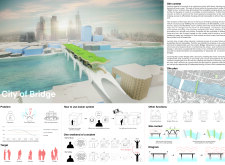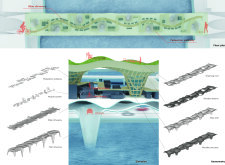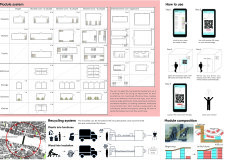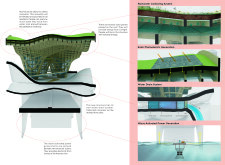5 key facts about this project
The primary function of the City of Bridge is to create a vibrant community space that combines residential units with essential amenities such as coworking spaces, dining areas, and recreational facilities. This blend of functions allows for a novel live-work environment, where residents can seamlessly integrate their professional and personal lives. By leveraging the space above the river, the project not only addresses housing shortages but also reclaims and revitalizes underutilized urban areas, fostering a stronger relationship between the city and its waterways.
The architectural design of the City of Bridge is characterized by a modular housing system, which offers residents the flexibility to choose from various configurations that meet their specific lifestyle requirements. This adaptability is one of the project’s hallmark features, allowing it to respond dynamically to the needs of its inhabitants. Each housing module is designed with functionality in mind, prioritizing efficient use of space while incorporating elements that enhance the living experience, such as natural light, ventilation, and aesthetic appeal.
Materials play a crucial role in the architectural approach of this project. The use of wooden beams provides structural integrity while also aligning with sustainability goals, promoting the use of renewable resources. Glass walls are strategically incorporated throughout the design to create an open atmosphere, allowing for unobstructed views of the river and immediate surroundings, which enhances the sense of connection to the environment. The green roof system further exemplifies the project’s commitment to sustainability by contributing to urban biodiversity and managing rainwater effectively.
One of the unique aspects of the City of Bridge is its focus on sustainability and energy efficiency. The architectural design integrates several innovative systems aimed at reducing the environmental footprint of the building. These include rainwater harvesting systems that collect and filter rainwater for residential use, solar photovoltaic panels that generate clean energy, and wave-activated power generation, which harnesses energy from the river’s tides. This multifaceted approach not only serves the immediate needs of the residents but also educates them on sustainable practices and resource conservation.
In addition to its strong emphasis on functionality and sustainability, the City of Bridge prioritizes communal spaces to foster social interaction and community engagement. The design thoughtfully incorporates public areas where residents can gather, creating opportunities for networking and collaboration. This aspect is particularly relevant in an urban context, where social connections can be challenging to establish amidst the hustle and bustle of city life.
The architectural ideas behind the City of Bridge offer a compelling case study in modern urban development, showcasing how existing structures can be transformed into meaningful, community-oriented environments. By prioritizing adaptability, sustainability, and social interaction, this project sets a precedent for future architectural endeavors within urban settings.
For those interested in exploring this project further, a closer look at the architectural plans, sections, and overall design can provide deeper insights into the multitude of concepts and strategies that have been employed. Understanding these elements will shed light on how architecture can respond effectively to contemporary urban challenges while enhancing the quality of life in vibrant city environments.


























